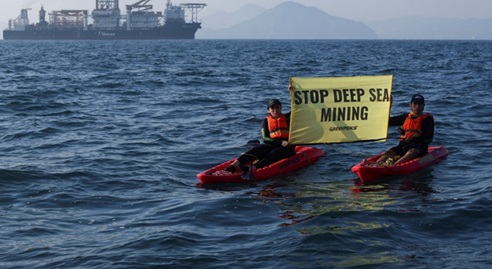Why in news?
A research study on the long-term impacts of deep-sea mining was published in the journal Nature.

About the research study
- Title: ‘Long term impact and biological recovery in a deep-sea mining track’
- Researchers: The study was conducted by a team of scientists from the UK National Marine Science Centre.
- Areas covered: The study examined the impact of small-scale mining extraction on a section of the sea floor of the Pacific Ocean.
- Key findings
- Mining since 1979 has caused significant changes in the sediments of the Pacific Ocean.
- Also, the population of large aquatic organisms living in this region has decreased.
- Even after more than 40 years of mining, the affected sea floor has not been restored.
Relevance of research
- Recently, 36 countries participated in the meeting of the Council of the United Nations International Seabed Authority held in Kingston, Jamaica, in which it was discussed whether mining companies should be allowed to extract metals from the sea floor.
- Other previous studies have expressed concern over harmful effects such as noise pollution, vibration and light pollution from mining below 200 meters.
- A 2023 study published in Current Biology found that wherever deep sea mining takes place, animal populations decrease and it leaves a more extensive footprint than previously thought.
About deep sea mining
- What is it: Deep sea mining is the process of extracting valuable metals and rare minerals found at depths of more than 200 meters below the sea floor.
- Types: There are three types of deep sea mining -
- Extraction of polymetallic nodules from the sea floor
- Mining of massive sulphide deposits in the sea floor
- Separation of cobalt crust from underwater rocks
- Need
- To meet the growing demand for minerals such as cobalt, copper, nickel and manganese
- To promote technologies such as batteries, solar panels and wind turbines
Effects of deep sea mining
Although deep sea mining is still in the experimental stage and studies on its impact on the ocean ecosystem are limited, it also shows the need for research on the long-term impact of deep sea mining. But scientists have been constantly warning about the environmental concerns arising from mining and say that the damage to the deep sea will probably be permanent.
The possible effects are as follows -
Effect on climate
- Deep sea mining can have a harmful effect on the climate as deep sea mining is an energy intensive industry with high greenhouse gas emissions.
- In such a situation, it can increase the climate crisis by increasing the emission of carbon and other greenhouse gases.
Habitat destruction and species extinction of marine organisms
- The use of heavy machinery used during mining and other activities harm the habitats of marine organisms.
- Due to loss of habitat and disruption of the ecosystem, rare species found in the deep sea are also at risk of extinction.
Noise and light pollution
- The noise and light produced by mining ships and equipment disrupt the natural, calm and dark environment of the deep sea.
- Which negatively affects many marine mammals and other species living in the deep sea who depend on sound and light for communication and navigation.
Impact on the ocean carbon cycle
- Deep-sea sediments contain large amounts of carbon deposits, and mining activities can increase carbon emissions by bringing carbon stored in these deposits to the surface.
- Deep-sea ecosystems play an important role in transporting carbon from the surface to the sea floor, and mining activities can disrupt the natural processes of the oceans, which can negatively affect the carbon storage capacity.



